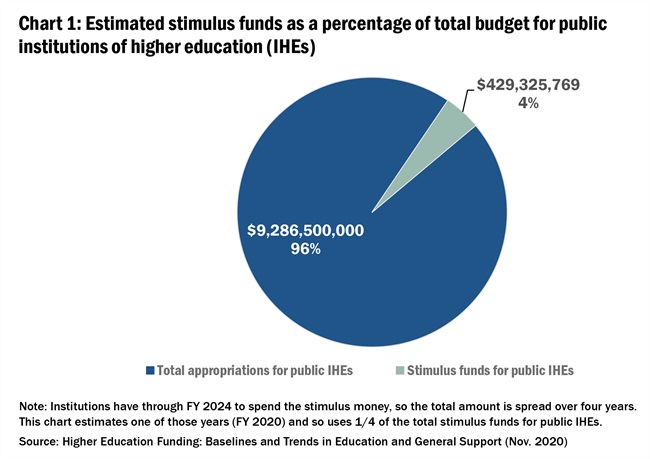Over the past two years, the federal government has directed billions of dollars to Virginia through three pieces of legislation designed to address the economic and public health effects of the COVID-19 pandemic. These three bills -- the Coronavirus Aid, Relief, and Economic Security (CARES) Act; the Coronavirus Response and Relief Supplemental Appropriations Act (CRRSAA); and the American Rescue Plan (ARP) Act -- allocated $1.84 billion directly to Virginia's students and institutions of higher education. Another $356 million for higher education came from Virginia's discretionary distribution of additional CARES, CRRSAA and ARP funds.

The majority of the federal stimulus money for higher education was distributed to public colleges and universities. (The funding formulas largely relied on enrollment, and more students attend public institutions than private ones.) Public four-year institutions and Richard Bland College received $1 billion from CARES, CRRSAA and ARP, while the Virginia Community College System received $582 million and private institutions received $482 million.
Of the total $2.2 billion flowing to higher education in Virginia, $696 million went directly to students through provisions in the Higher Education Emergency Relief Fund (HEERF) present in all three bills. Student aid also was a significant portion of the Governor's Emergency Educational Relief Fund (GEERF) from CARES and ARP. As such, student aid represented at least one third of all higher education relief funding in Virginia. For more information on how colleges and universities have spent their stimulus funds, you can visit this aggregating tool from the U.S. Department of Education.

The $356 million distributed by the state came from three sections of stimulus funding legislation and represents 7% of the total stimulus money for Virginia higher education. Two iterations of the Governor's Emergency Education Relief Fund (GEERF) -- under ARP and CARES -- gave state governors discretionary funds to use for higher education relief. The state will distribute additional funds from the ARP State and Local Fiscal Recovery Fund (SLFRF), which were allocated to SCHEV by the General Assembly during the second 2021 Special Session. That money ($100 million for students attending public colleges and universities and $11 million for privates) will be distributed in early 2022. For a more detailed look at Virginia's SLFRF spending, see this tool from The Council of State Governments.
The takeaway
Although the stimulus bills provided a windfall for Virginia higher education, these are one-time funds and so are unable to be used for recurring expenses, such as faculty pay or financial aid renewals. In order to remain competitive with public colleges and universities in other states, Virginia needs to prioritize higher education in every budget bill. In addition, when spread over the four years that the institutions have to spend the money, the stimulus funding for public institutions equates to less than 5% of the state's public higher education budget. (For more information on the higher education budget, see SCHEV's November 2020 report, "Higher Education Funding: Baselines and Trends in Education and General Support.") And while the $696 million for student aid is welcome support, the unmet need of students attending Virginia public institutions totaled $1.2 billion in 2019-20.

The Virginia Plan for Higher Education, Pathways to Opportunity, sets a goal for Virginia to become the best state for education, with 70% of adults having earned a college degree or credential by 2030 and creating a system that is equitable, affordable and transformative. To help achieve those goals, SCHEV recently recommended the state invest an additional $700 million in higher education in the next biennial budget. Two categories made up the lion’s share: $224 million for faculty talent and to avoid steep tuition increases, and $150 million for need-based undergraduate aid. These long-term priorities cannot be met with federal stimulus dollars, which are limited, one-time funds. With the new General Assembly session starting in January 2022, hopefully we will see additional investments for higher education in Virginia to meet our long-term goals.
Welcome to Insights, SCHEV's platform to interpret and communicate data and policy with the overall goal of informing policy-making, engaging institutions and drawing attention to these resources. Centered around SCHEV's nationally leading data collection, each Insight will visualize complex ideas and help inform funding and policy decisions.
